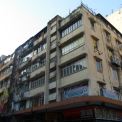The government began in 1931 to collect information on the wage levels and cost of living among workers. In the 1930s, unskilled men who earned on average $15-50 a month had to spend $10-20 on food, housing and clothes while unskilled working couples earning $25 a month had to spend $17-20 on daily necessities. The government admitted that many workers were very poor and the wages of some industries were unjustly low.
In 1939, Hong Kong’s first Labour Officer provided the first comprehensive review of labour and labour conditions in the colony. To investigate worker’s livelihood, he interviewed people in different trades, including hawkers, coolies, outworkers, factory workers, salesperson, dock workers, shop workers, domestic servants, white-collar employees, farmers and fishermen. He found that most of them were migrants from various parts of Guangdong. They resided in cramped environments, ranging from shared bedspaces to cocklofts and cubicles in tenements and lived under various types of split family structure.
The workers earned from a range of $2-$45 monthly for 10 to 13 hours’ work a day. Women were mostly unskilled piece workers earning from $0.2-$1 a day, and skilled men like drivers, carpenters, plasterers, coppersmith and boilermakers earned $0.8-1.8 dollars. Some male workers were permanent employees with monthly earnings from tens to over a hundred dollars plus free board and lodging.
In 1939, Hong Kong’s first Labour Officer provided the first comprehensive review of labour and labour conditions in the colony. To investigate worker’s livelihood, he interviewed people in different trades, including hawkers, coolies, outworkers, factory workers, salesperson, dock workers, shop workers, domestic servants, white-collar employees, farmers and fishermen. He found that most of them were migrants from various parts of Guangdong. They resided in cramped environments, ranging from shared bedspaces to cocklofts and cubicles in tenements and lived under various types of split family structure.
The workers earned from a range of $2-$45 monthly for 10 to 13 hours’ work a day. Women were mostly unskilled piece workers earning from $0.2-$1 a day, and skilled men like drivers, carpenters, plasterers, coppersmith and boilermakers earned $0.8-1.8 dollars. Some male workers were permanent employees with monthly earnings from tens to over a hundred dollars plus free board and lodging.
Documents
- Report by the Labour Officer Mr H.R. Butters on Labour and Labour Conditions in Hong Kong (SP1939, no.3)
- Wages and Cost of Living (1939)
- Housing (1939)
- "Accidents, Medical Treatment and Compensation" (1939)
- "Education" (1939)
- Wages and Cost of Living (1931)
- Wages and Cost of Living (1932)
- Wages and Cost of Living (1933)
- Wages and Cost of Living (1934)
- Wages and Cost of Living (1935)
- Wages and Cost of Living (1936)
- Wages and Cost of Living (1937)
- Wages and Cost of Living (1938)
- Wages and Cost of Living (1939)
- Report of the Housing Commission (1923)
- Report of the Housing Commission (1935)





